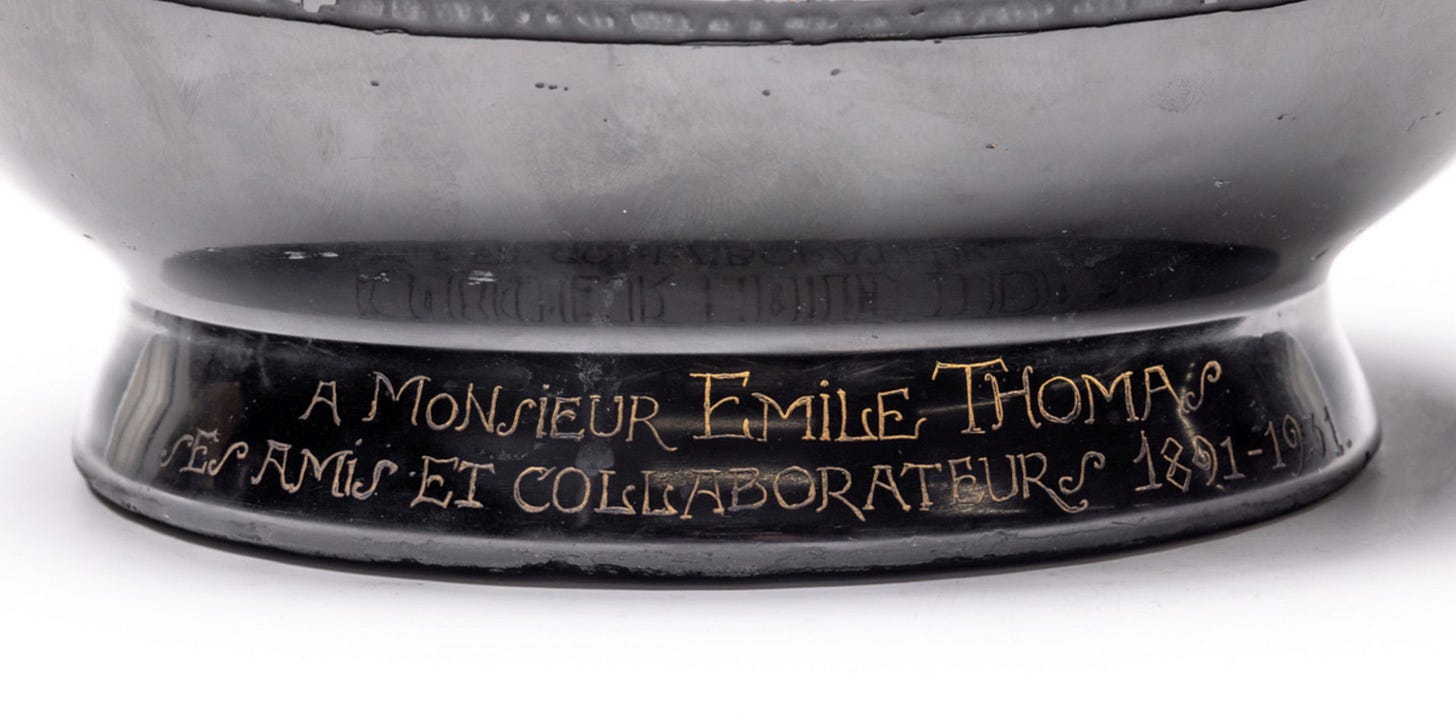Art glass vases as corporate honorary gifts: a Pont-à-Mousson SA case study, part one, Gallé
The Thomas vase (1931)
The Émile Thomas vase (1931)
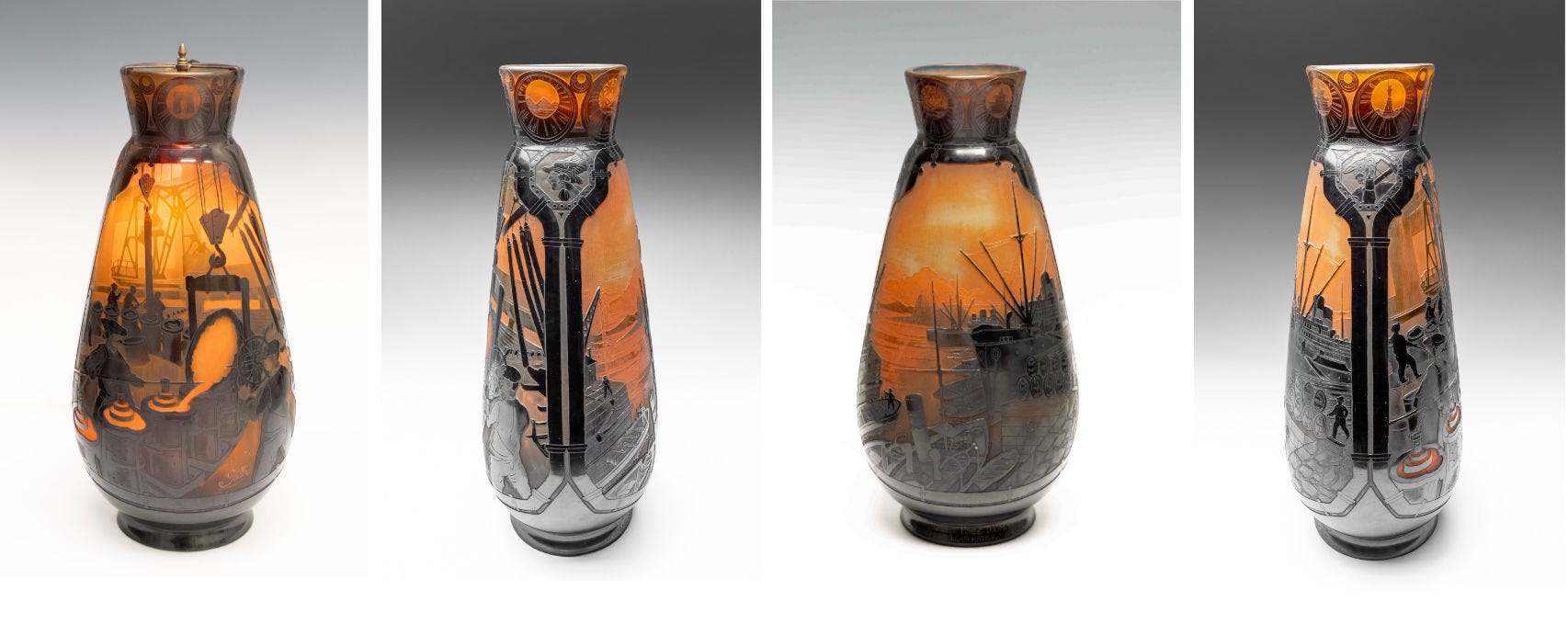
The New Art Est-Ouest auction house in Tokyo has an exceptional Gallé vase on sale next week: a large size (60 cm high) classic high necked bottle shape, with a two-layers, orange and black, acid-etched decor, it stands out for its hitherto unknown (at least to me) industrial theme and its dedicative inscription to one Émile Thomas (1891-1931).1

The Thomas vase, as we can therefore call it, has a decor pattern that is immediately recognisable as belonging to the official iconography of the company Hauts-Fourneaux et Fonderies de Pont-à-Mousson (abbreviated PAM SA below): in the inter-war period, this was one of the most important steel companies in France, and therefore in Lorraine, whose world-renowned speciality was the production of cast-iron pipes for water supply. The company was bought by Saint-Gobain SA in 1970, but it continues to produce cast iron using blast furnaces, from which it makes various kind of products, among which the ubiquitous manhole or sewerage covers bearing its logo (in shape of an arched bridge) and its abbreviated name, PAM.
A setting emblematic of the production and export of cast-iron pipes
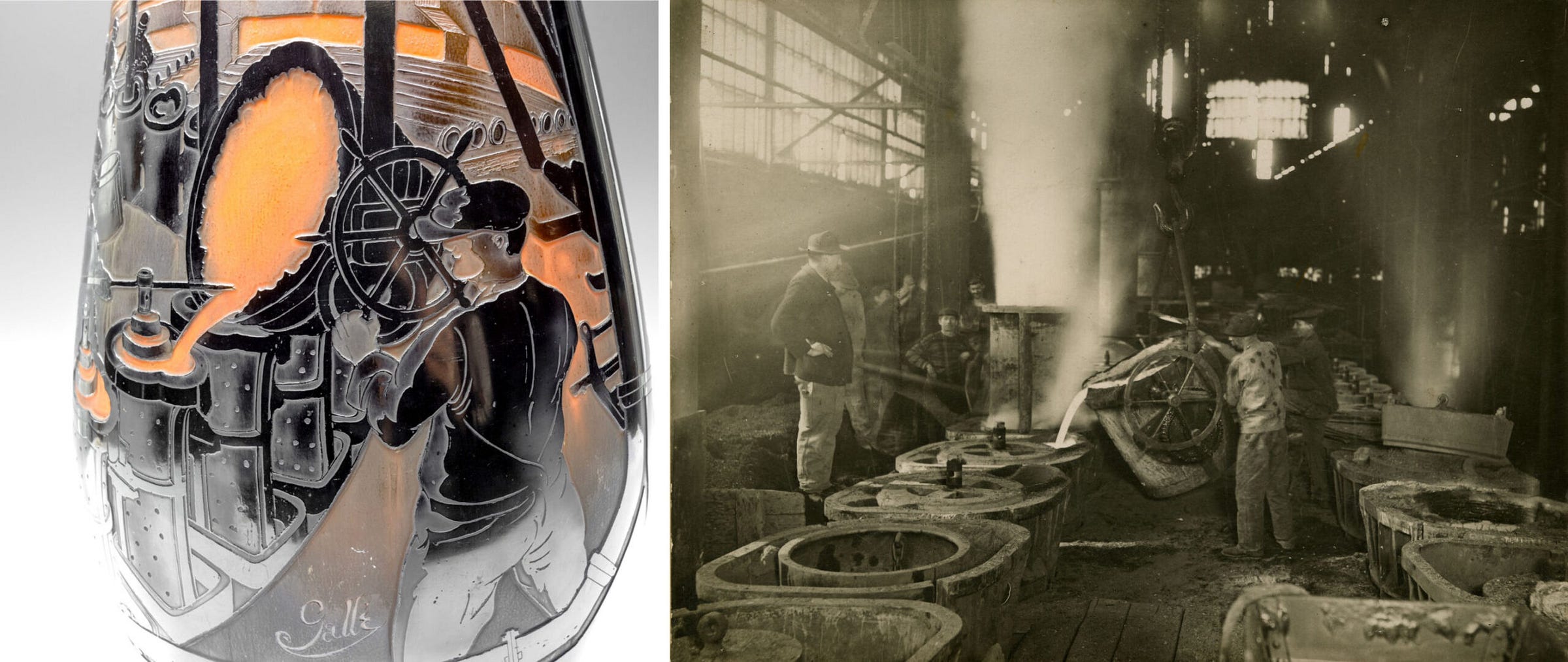
The decoration on the vase is structured around two main sides delimited by a frame consisting of a riveted cast iron pipe and presenting two scenes, the production and export of these pipes. The production scene shows the pouring of cast iron, known as ladling: in the Auboué factory, the main production site, two workers manoeuvre to pour the molten iron into a series of vertical moulds arranged on a carousel. This is an emblematic scene of the main manufacturing operation, often depicted in photographs and pictorial works in PAM SA's communications from 1910-1920.
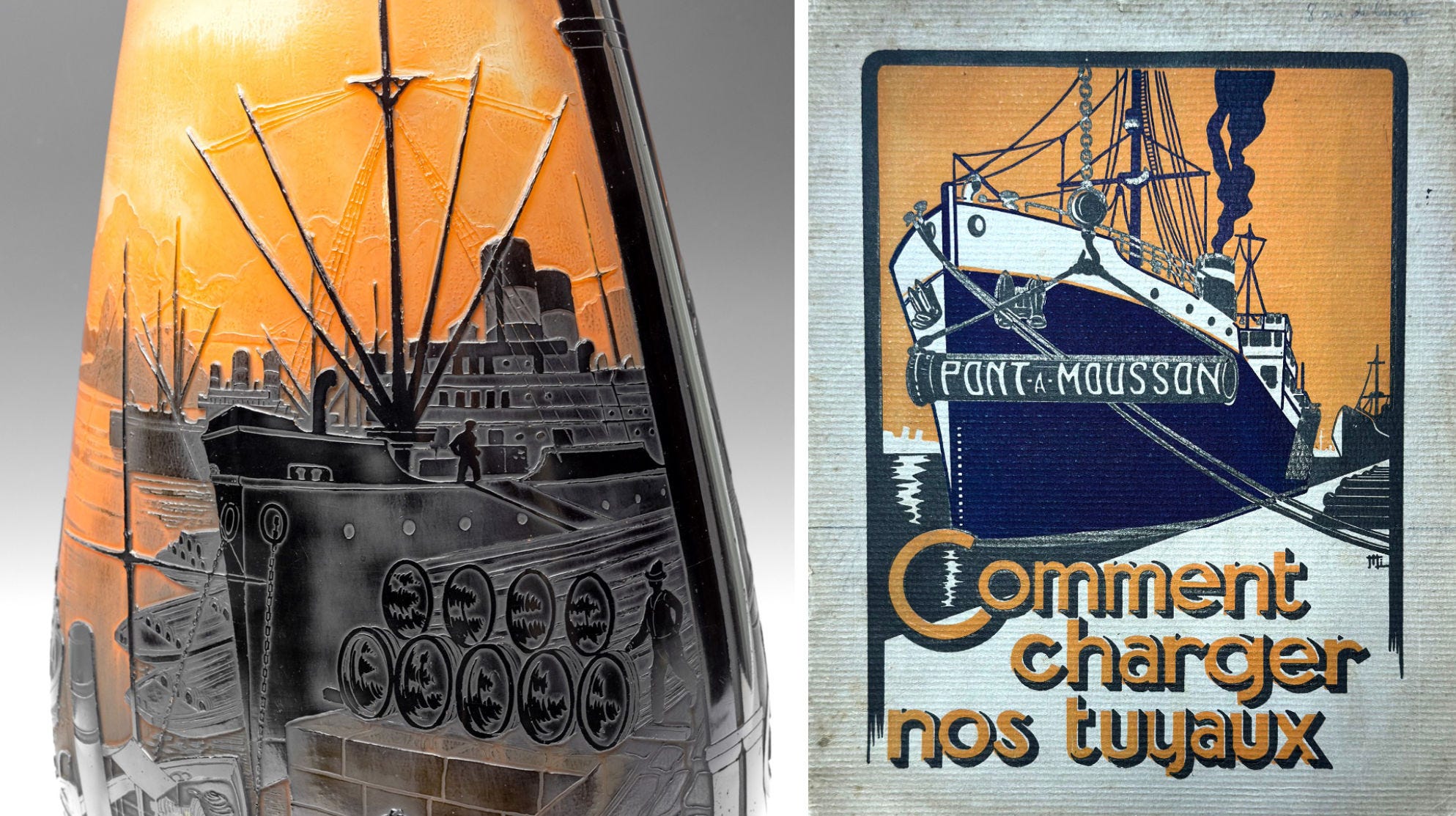
The export scene, for its part, shows a stock of pipes just unloaded on barges and on the wharfs of Rio de Janeiro’s port, identifiable thanks to the famous Sugar Loaf that dominates the skyline in the background: the company PAM SA exported its products all over the world by sea, and it did indeed have a branch in Brazil, in Rio. It took great care when loading pipes onto ships, to avoid any damage, and had even produced a minutely detailed manual for these operations.
It must be noted that despite the completely different theme on the two main sides of the vase (in itself a rarity in the Établissements Gallé glass products), the dark brown-over-orange unitary colour scheme works really well. On the manufacturing side, it evokes the dirt, the hot and stuffy atmosphere of the factory lighted up by the yellowish stream of molten iron. On the Rio de Janeiro landscape side, the sky has the orange hue of the setting sun – a colour scheme already in use by the Établissements Gallé for some of their Rio de Janeiro series (see below at the end of this article).

The decoration is completed on the vase’s neck by a series of five circular vignettes, offering views of monuments or landscapes emblematic of the company's commercial outlets over the five continents, cleverly depicted as seen through the striated cylinder of a pipe, acting like a telescope: the pyramids of Egypt for Africa, the Arc de Triomphe for Paris and Europe, the Statue of Liberty for New York and North America, a pagoda for Asia, palm trees by the sea for South America.2
The theme of the worldwide reach of the company and its products was a common one in its propaganda, a source of local and national pride. In 1923, the French President Raymond Poincaré had awarded Camille Cavallier, the company’s CEO at the time, a special honour, the Grande Médaille d’Or du Commerce Extérieur de la France, for its commercial success. In his discourse, made in the Sorbonne University, on the 8th December 1923, Poincaré extolled the universal ubiquity of PAM SA products in this manner:
Il n'existe pas, en effet, de pays au monde qui n'ait été visité par les Agents de Pont-à-Mousson. Presque sur tous les marchés d'outre-mer, Pont-à-Mousson a triomphé de la concurrence étrangère et a réussi à introduire nos produits.
Actuellement, 458 villes étrangères, dont 323 en Europe, 29 en Asie, 16 en Afrique, 89 en Amérique et 5 en Océanie, utilisent, grâce à l'initiative et à l'effort soutenu de M. C. CAVALLIER, des produits métallurgiques fabriqués en France.
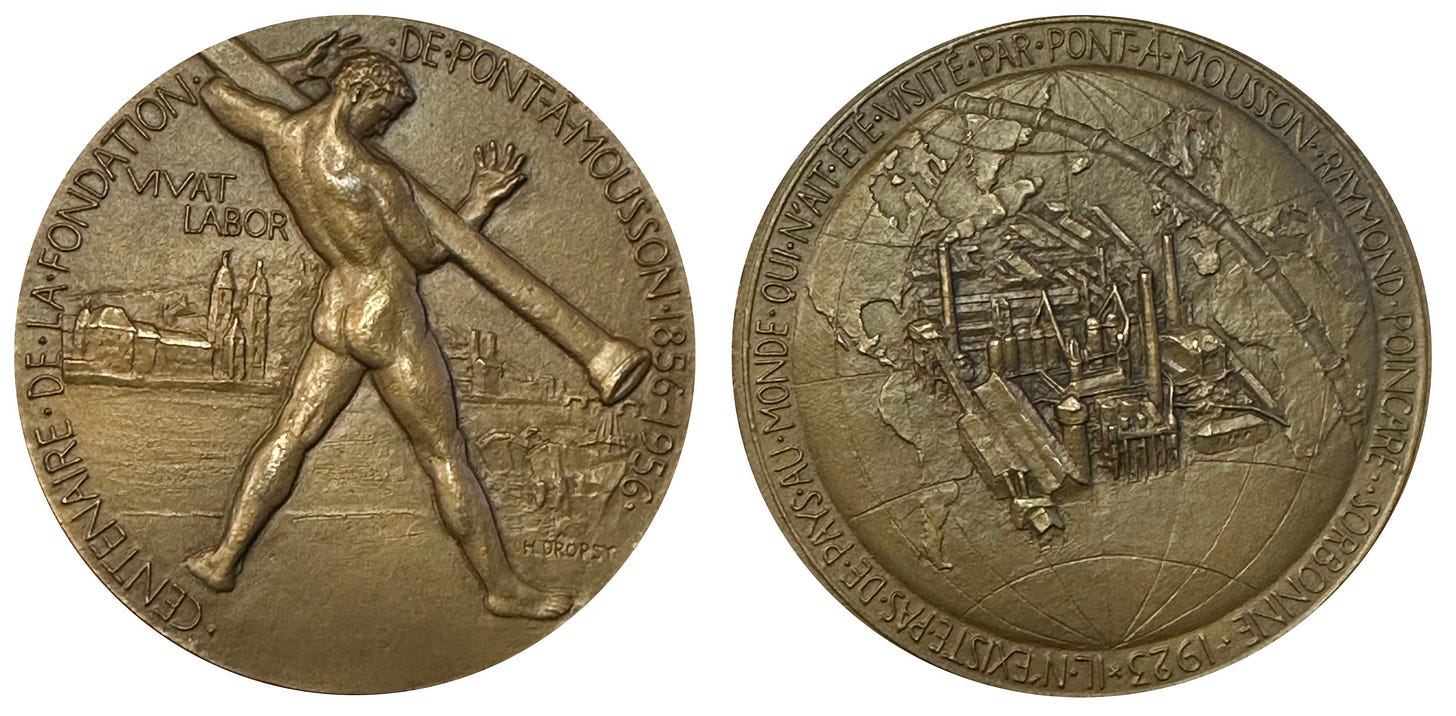
The speech pleased so much Cavallier and his successors that it was quoted on the special medal the company commissioned more than 30 years later, for its centenary anniversary, in 1956, with a matching iconography showing the PAM SA pipes circling the world.

Two portraits in irregular octagonal medallions complete the decoration on the shoulders of the vase: firstly, that of a miner, recognisable by his pickaxe and mining lamp, a reminder that PAM SA obtains coal from its own mines, notably in Auboué, to fuel its blast furnaces; and secondly, that of the Greek god Hermes, identifiable by the winged helmet, the petasus, and the canvas money purse he holds up in his left hand. It symbolises trade and therefore PAM SA's export success.
Émile Thomas as the vase’s recipient
Compared with other contemporary vases celebrating PAM SA, the Thomas vase stands out in two ways. While it uses motifs that are emblematic of the company (the manufacture of pipes and their export by sea), it omits others that are just as, if not more, important in the company's communication: the mine installations and the blast furnace number 3 at Auboué, an emblematic site for the company that its directors, Camille Cavallier and then Marcel Paul-Cavallier, favoured, as can be seen on contemporary Daum vases.

Above all, however, there is no mention of the company Hauts-Fourneaux et Fonderies de Pont-à-Mousson, with its famous logo superimposed on a schematic representation of a blast furnace belching out cast iron and incandescent smoke. This is all the more surprising, at first glance, given that this logo, which can be likened to a coat of arms, is omnipresent in the company's communications: it adorns all its publications and advertisements, and appears everywhere on its buildings, from the entrance gates to its production sites to the entrance hall of its head office.
The reason for this omission relates to the identity of the recipient of this vase and probably to the circumstances of the gift. The engraved (?) and enamelled inscription on the recessed foot at the base of the vase indicates that it was a gift:
À Monsieur Emile Thomas / ses amis et ses collaborateurs 1891-1931.
Émile Thomas (Pont-à-Mousson, 23 May 1879- Nancy, 17 January 1957) was a senior executive at PAM SA, where he was appointed deputy sales director on 1 October 19313. A native of Pont-à-Mousson and the son of a moulder, Émile Thomas spent his entire career working for PAM SA, which also employed two of his sons in the sales department he headed. PAM's chairman, Marcel Paul Cavallier, was fond of using this family, which had served the company for three generations, as an example in his speeches - as he did on the company’s Labour Day on 12 November 1933.4 The prominent position of Émile Thomas in the company was already highlighted in 1925, when his portrait was included, as were those of the other directors, in the jubilee guest book offered to the PAM president, Camille Cavallier. On 26 November 1938, Camille Cavallier’s successor, Marcel Paul presented Émile Thomas with the Légion d'honneur, the ultimate recognition of his role as one of the company's most important executives, responsible for marketing its products worldwide.

1931 was a banner year in Émile Thomas's career: he helped organise PAM SA's participation in several international exhibitions, in Milan in April and September, and in Paris for the famous Colonial Exhibition, for which he received awards. In addition, he had joined the company in 1891, and in 1931 he celebrated 40 years of service, which is what the inscription refers to.
The vase probably celebrates one of two events - or perhaps both - his promotion to one of the most important positions or his loyalty to the company. Every year, PAM SA organised a "fête du travail" to celebrate its most deserving employees, particularly those with the greatest seniority, and above all its managers, especially when they received an official award or honour, such as the Légion d'honneur. At a banquet, the company's management would present a medal to employees who had been honoured in this way. This was the case for Émile Thomas, who was awarded the Médaille d'honneur du travail in 1931.
However, the wording of the dedication inscription, which simply refers to "his friends and collaborators", and the absence of any mention of the company, by name or logo, imply that the Gallé vase was not an official commission from PAM SA to reward its loyal employee. It was a private gift, which must have been the subject of a subscription organised by Émile Thomas's friends and family, as was regularly done to honour a retirement or promotion. The absence of any mention of PAM SA even suggests that it refused to take part, perhaps because Marcel Paul felt that the honour was inappropriate for an executive, in that it was too similar to the tributes reserved for management - but this is some speculation, at this stage, that would need to be verified.
The decoration of the vase, a pastiche of the decoration of PAM SA's new head office (1928)

The choice of design commissioned from Établissements Gallé for the vase - for it is indeed a unique work - was therefore dictated by the career of Émile Thomas, the new deputy sales director, who was less interested in the mines and factories than in marketing the products. In this regard, the most personal detail on the vase is the inclusion of Hermes as the God of Trade, a direct allusion to Thomas as the head of the sales department. But he was certainly also greatly influenced by the building in which he worked: from 1928, like the rest of the company's management, he occupied an office in the new headquarters that PAM SA had had built in Nancy, on rue de Toul.
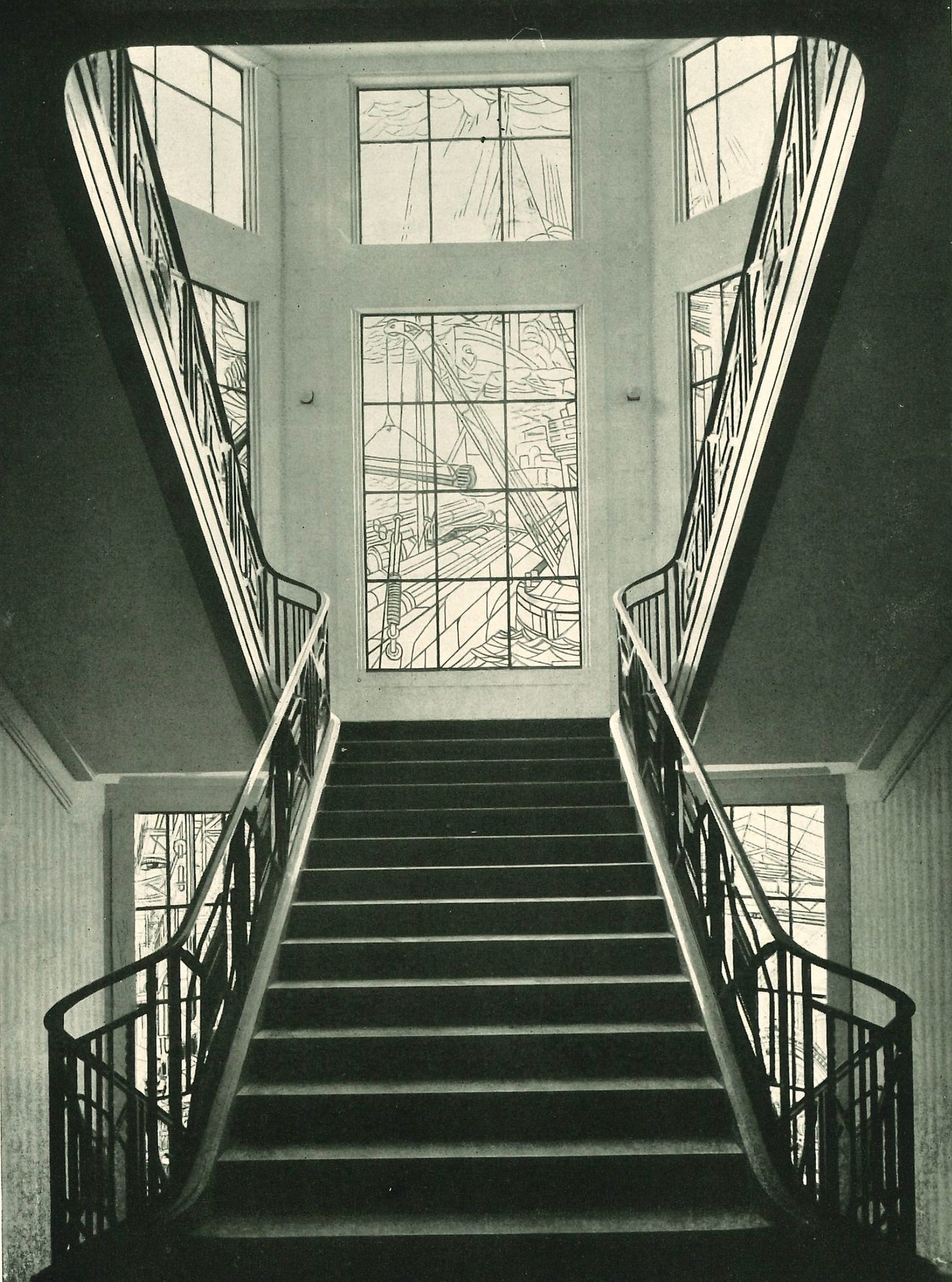
Designed by the architect Jean Bourgon, the new building benefited from considerable investment, and the project was carefully prepared and monitored by the chairmen of PAM SA, Camille Cavallier (who died on 10 June 1926, at the start of construction) and then Marcel Paul, to provide a new monumental and prestigious setting for the company's management. The building was designed in the modern style, now known as Art Deco, that was so popular at the time. It mobilised a team of decorators who had already distinguished themselves in 1925 at the Exposition Internationale des Arts Décoratifs et Industriels Modernes with the design of the Nancy and Eastern France Pavilion. The lobby and main staircase of PAM SA's head office in particular received a spectacular décor, combining cast-iron bas-reliefs by Émile Just Bachelet, an ironwork staircase ramp by Raymond Subes and, above all, a set of stained-glass windows by Jacques Grüber that adorned the landings on three floors, including the management level. Other artists included the young Jean Prouvé, who contributed the rail of a secondary stair, André Lemoine, an important stain glass designer in Nancy, for the employee’s stairs windows, and Edgar Brandt for the massive iron-forged front doors.

The new headquarters were immediately recognised as a major contribution in the new Art Deco style, not only in Nancy, but in France: Jean Bourgon presented models of the buildings at the 19th Salon de la Société des Artistes Décorateurs in Paris in May-July 1929; with the other designers, he produced an honorary book (Livre d’or) commemorating their collaboration in the completion of the building with original graphic works. Marcel Paul had a commemorative booklet published, richly illustrated with photographs of the facades and interiors and their décor. Photographs of the building were published in several specialised art magazines, as a fine specimen of the new architecture at the time.

Émile Thomas could contemplate this impressive setting at leisure every day when he went up to his office as deputy director on the 2nd floor of the head office. There is little doubt that the designer at Établissements Gallé was asked to draw inspiration from these works to create a vase that would remind Émile Thomas of this prestigious setting: Firstly, from Grüber's stained glass windows, as the pouring of the large pipes in the factory hall is depicted in the left-hand window on the second landing, while the unloading of the pipes from a ship is the motif of the central window on the third landing; secondly from the reliefs by Émile Just Bachelet, as well, as the pouring of the cast iron is depicted several times in the lobby, while the miner’s portrait in medallion on the vase finds its counterpart in the miner’s portrait also part of this frieze, with a matching metallurgist on the other side of the hall – the figure to which the Gallé designer substituted Hermes as a more apt allusion to the honoree’s occupation. The decoration on the Gallé vase is thus best understood as a genuine pastiche of part of the decoration on the PAM SA headquarters.
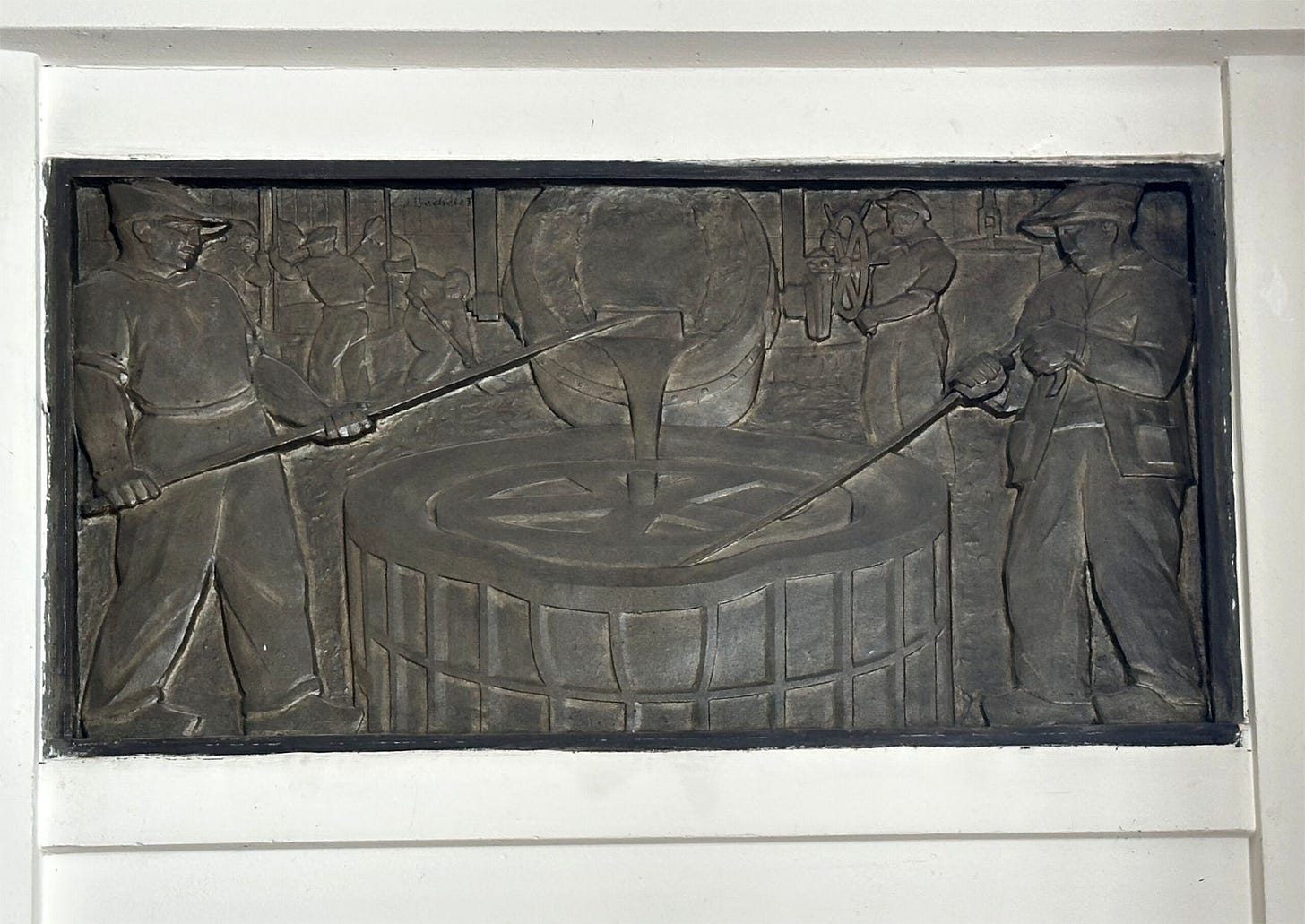
Attribution of the vase to Auguste Herbst, artistic director of Établissements Gallé
While the vase certainly came from the Établissements Gallé, as the signature attests, and is of the Mk VI type as was more often the case around 1925-1936, the question arises as to its more precise attribution. We know that at this time the most prestigious commissions were taken on directly by the artistic director Auguste Herbst – this was the case for the Mouettes vase in 1927, for example – and there is little doubt that this was also the case for the Thomas vase.

It was Auguste Herbst who designed the decor for the Rio de Janeiro landscapes vases, elements of which are used in the composition of the scene.5 He is also known for his watercolours of industrial landscapes in the Moselle valley. Finally, after the closure of Établissements Gallé, he worked as a commissioned decorative artist or illustrator on various projects, including some for PAM SA: for example, he designed the decor for the menu and the commemorative brochure for the fête du travail on 9 March 1939, a humorous pastiche on the theme of Walt Disney’s Snow White and the Seven Dwarfs(1937), a major cinematic success in France the previous year. In his drawing, the PAM miners are depicted as the dwarves from the fairy tale, in accordance with the banquet theme, which even included a rewriting of the famous dwarves’ song. Obviously, there isn’t any link between this humorous work and the industrial scenes on the Thomas vase, but the commission given to Herbst might have been spurred by some earlier work.

If, as can be assumed, Émile Thomas's "friends and collaborators" got together to have the vase made in time for his promotion in November 1931, the order had to be placed with Établissements Gallé in the summer of 1931 at the latest. It was at the end of that summer that the furnaces at the glassworks were shut down for good. Auguste Herbst was made redundant shortly afterwards and it is likely that there were no more special orders in the following years, although the decoration workshops continued to work from stock. The Thomas vase is therefore an important piece of production for this additional reason, as it surely represents one of the last private orders made to the Établissements Gallé.
Coming next in part two : the Daum vases for PAM SA compared to the Gallé one.
© Samuel Provost, 12 April 2025.
Post Scriptum
By a strange, truly unbelievable coincidence, I had been studying for more than three months the decor of PAM SA’s headquarters, as the curator of an exhibition organised there with my graduate students, when the Thomas vase appeared on the auctions’ website. In fact, the exhibition, titled “De verre et de fer, quand l’art déco rencontre l’industrie, le siège nancéien des Hauts-Fourneaux et Fonderies de Pont-à-Mousson” opened last week, as part of a large program meant to celebrate in Nancy and its area the 100 years anniversary of the 1925 Paris Art Deco exhibition. It was therefore too late to include it in our presentation, but we hope to produce a catalogue doubling as the building’s guidebook, in which it will be included. There are two Daum vases featured in the exhibition (one only in picture, sadly), however, which I will comment upon in another article. In the meantime, the exhibition remains opened until the 31st of August. The visit is free but it must be booked on a website, here and there.
Bibliography
THOMAS Émile, Leonore database of the Légion d’honneur recipients, Archives nationales, file 19800035/194/25306 [online]
Société anonyme des Hauts-Fourneaux et Fonderies de Pont-à-Mousson,
s. d. Des précautions à prendre pour l’Embarquement des Tuyaux en Fonte, Royer, Nancy.
1912, Division d’Auboué, Mines & Hauts-Fourneaux, Ernest Mézière photographe éditeurs, Paris.
1930, Construction et organisation de son siège administratif, commercial et technique, Place Camille Cavallier, à Nancy, Imprimerie Pafesty, Nancy.
1930, Visite de l’Ambassadeur des États-Unis aux Usines de Pont-à-Mousson, 15 Avril 1930, Imprimerie Pafesty, Nancy.
1932, La Fête du Travail dans la salle des fêtes des Usines de Pont-à-Mousson, 10 juillet 1932, Imprimerie Pafesty, Nancy.
1939, Fête du Travail du 19 mars 1939, Remise de la Croix de Chevalier de la Légion d’Honneur à M. Jean Cavallier, Directeur Général Adjoint de la Société, Imprimerie Pafesty, Nancy.
Jean Bourgon architecte diplomé par le gouvernement. Quelques réalisations architecturales 1922-1933, Strasbourg, Edari, 1934.
Footnotes
I am very thankful to the New Art Est-Ouest auction for allowing me to publish their pictures of this vase. I also have to thank Nathalie Duarte, documentalist at the Saint-Gobain archives in Blois, as well as Jean-Pierre Bardot, head of the Pont-à-Mousson historical museum, Au Fil du Papier, for their invaluable help in researching the Pont-à-Mousson SA history. My final thanks go to my students in the Histoire de l’Art - Métiers des Musées et des Expositions master’s program, in the University of Lorraine, and to my de facto research assistant Alexandre Miot, a talented researcher in his own right.
I have to thank Mike Moir for pointing out the reference to the continents.
His personal file as a recipient of the Légion d’Honneur gives a full summary of his career : unless stated otherwise, all the information given in this article comes from this source.
Une fête du travail aux Fonderies de Pont-à-Mousson, L’Éclair de l’Est, 19 November 1933.
I already briefly suggested as much while discussing the Lake of Como vases. I also justifed my chronology of the Rio de Janeiro vases, in the first article of this newsletter, but without weighing on its attribution, a matter I will return to in the future.
How to cite this article : Samuel Provost, “Gallé glass vases as corporate honorary gifts: a Pont-à-Mousson SA case study, the Émile Thomas vase (1931)”, Newsletter on Art Nouveau Craftwork & Industry, no 31, 12 April 2025 [link].




